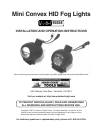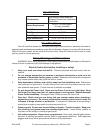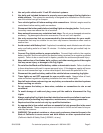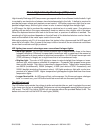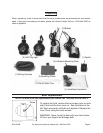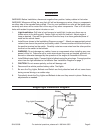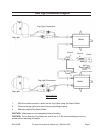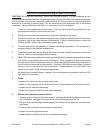
SKU 95058 For technical questions, please call 1-800-444-3353 Page 8
Care and Troubleshooting of your HID Lights
CAUTION: HID lamps emit ultraviolet, visible, and infrared radiation. HID bulbs operate at very
high temperatures and pressures. Possible skin or eye irritation can result from exposures exceed-
ing 15 minutes. Do not stare at exposed lamp in operation. During operation, the bulb should be
enclosed in a housing to prevent injury. Do not remove bulb from equipment until it has cooled
completely. Never handle the bulb when it is operating or until it has cooled!
The lens of the lamps must be kept clean. The Fog Lights should be handled with care,
giving special attention to the quartz arc tube.
Maintain proper electrical wiring polarity to prevent damage to the lamp.
Protect the quartz arc tube when handling the lamp. Keep the arc lamp clean. Do not touch
the quartz tube or the inside surface of the reflector. If tube or reflector are dirty, clean with
rubbing alcohol. Allow to dry completely before lighting.
The bulb and ballast are sensitive to external operating temperature. Do not expose to
extremely high or low ambient temperature.
Periodically clean the lamp by wiping with a lint free towel or swab immersed in denatured
alcohol. Allow to dry completely before lighting.
While HID bulbs last considerably longer than halogen bulbs, several characteristics indicate
that a bulb is approaching the end of its life-span. Initial symptoms of end-of-life include
low light output and/or intermittent starting. Visual signs include blackening at the ends of
the arc tube and electrode tip deterioration. Note that HID bulbs contain metals, including
mercury, that can be harmful to the environment. Please dispose of any HID bulb in ac-
cordance with local, state, and federal regulations.
All lamps have a limited lifespan. However, if you are experiencing problems with your HID
light inspect the following:
Bulbs:
Inspect for broken arc tube or outer lamp jacket
Make a visual inspection of the bulb for broken or loose components in lamp envelope
Inspect for arc tube end blackening
Inspect for deposits inside the outer glass envelope
Ballast and Capacitor points-of-failure:
Attempt ignition a second time after properly resetting the ballast by disconnecting, wait-
ing 15 seconds, and then reconnecting the connectors attached to the lid.
Are you using identical replacement lamps? Your ballast will not work with incorrect watt-
age lamps.
Avoid possible overheat due to ambient temperature
Inspect for miswiring/pinched wires
Inspect ballast housing and wiring for mechanical damage
1.
2.
3.
4.
5.
6.
7.
8.
•
•
•
•
9.
•
•
•
•
•



